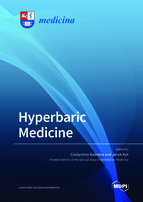Hyperbaric Medicine
A special issue of Medicina (ISSN 1648-9144).
Deadline for manuscript submissions: closed (1 January 2022) | Viewed by 55155
Special Issue Editors
Interests: extreme environments; oxygen; integrative physiology; diving; space physiology; pathophysiology; hyperbaric medicine; personalized medicine; cellular responses
Special Issues, Collections and Topics in MDPI journals
Special Issue Information
Dear Colleagues,
The usual path in medical sciences is almost always the same: understanding mechanisms, cellular tests, tissues, small animals, larger animals, human studies, clinical studies, etc.
It seems totally useless to be reminded that, albeit normal path, hyperbaric medicine has been developed in an unusual way.
In fact, during the 1950s, a Dutch cardiac surgeon (Ite Boerema) started to use a system that was considered efficient in curing divers affected with the so-called “caissons’ disease” to help his young patients called “blue babies”. The procedure to mend cardiac septal defects needed a cardiac arrest, and the time for such a cardiac arrest to secure a cardiovascular restart was a matter of minutes (Boerema et al., 1960).
At that moment, an unacceptable amount of such patients were not surviving the surgery, and this surgeon wanted to find a way that would allow him to achieve better outcomes. In order to have the chance to increase the survival rate, a longer period of cardiac arrest with good recovery chances was needed.
Increasing circulating oxygen level in the body by increasing barometric pressure in the operating room will permit survival even after a more prolonged cardiac arrest. Of course, some years after, extracorporeal circulation has become available and the “hyperbaric operating room” was no longer an option.
Since that very moment, a lot of hyperbaric centres have been developed and a long list of indications and procedures were produced.
This medical field was so “dispersive” that some reactions rose, and hyperbaric medicine was even “coined” a: “therapy in search of diseases” (Phillips, 2000).
Very important progress has been made since 1960, when Life without Blood was published, mechanisms that are underlying oxygen variations have been rewarded by a Nobel prize in 2019 (Lopez-Barneo and Simon, 2020) and this is an important milestone in the field since today we have enough understanding to tackle two major points that still need to be investigated in Hyperbaric Medicine: how much and how often. Hyperbaric medicine should be called “oxygen medicine”, a large range of oxygen levels may be used and, according to these levels, repetitions of sessions have to be adapted. Today, the dose (pressure) and repetitions of hyperbaric medicine are regulated mostly to cope with pulmonary and neurological toxicity, mainly calculating OTUs (Oxygen Toxicity Units) or UTPDs (Units of Pulmonary Toxicity Doses) to stay on the safe side and not harm the patient; these calculations accepted by everyone are nowadays increasingly challenged by new approaches (Arieli, 2020; Arieli and Aviner, 2020; Aviner et al., 2020; Wingelaar et al., 2020).
We therefore have the opportunity to get “back to basics” since hyperbaric medicine, and in parallel diving medicine, is getting out of its infancy.
However, as in real life, with infancy the certainties also disappear. It is now our task, as researchers, to reflect upon these uncertainties and distil out of them coherent, balanced advice towards researchers, physicians and patients. Let us not jump to conclusions too quickly, as our new “certainties”, again, may very well prove to be “not the whole story” (Balestra et al., 2019). This Special Issue is dedicated to increase knowledge in this very interesting field which investigates oxygen on the whole range of its use.
Prof. Costantino Balestra
Prof. Jacek Kot
Guest Editors
Manuscript Submission Information
Manuscripts should be submitted online at www.mdpi.com by registering and logging in to this website. Once you are registered, click here to go to the submission form. Manuscripts can be submitted until the deadline. All submissions that pass pre-check are peer-reviewed. Accepted papers will be published continuously in the journal (as soon as accepted) and will be listed together on the special issue website. Research articles, review articles as well as short communications are invited. For planned papers, a title and short abstract (about 100 words) can be sent to the Editorial Office for announcement on this website.
Submitted manuscripts should not have been published previously, nor be under consideration for publication elsewhere (except conference proceedings papers). All manuscripts are thoroughly refereed through a single-blind peer-review process. A guide for authors and other relevant information for submission of manuscripts is available on the Instructions for Authors page. Medicina is an international peer-reviewed open access monthly journal published by MDPI.
Please visit the Instructions for Authors page before submitting a manuscript. The Article Processing Charge (APC) for publication in this open access journal is 1800 CHF (Swiss Francs). Submitted papers should be well formatted and use good English. Authors may use MDPI's English editing service prior to publication or during author revisions.
Keywords
- Cancer
- Oxidative Stress
- Critical Care
- Environmental Stresses
- Nitric Oxide
- Hypoxia
- Oxygen
- Medical Research
- Extreme Environments
- Diving
- Aerospace








